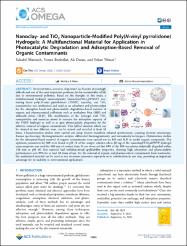| dc.contributor.author | Duran, Ali | |
| dc.contributor.author | Marouch, Salsabil | |
| dc.contributor.author | Benbellat, Noura | |
| dc.contributor.author | Yılmaz, Erkan | |
| dc.date.accessioned | 2022-11-14T07:28:55Z | |
| dc.date.available | 2022-11-14T07:28:55Z | |
| dc.date.issued | 2022 | en_US |
| dc.identifier.uri | https://doi.org/10.1021/acsomega.2c04595?urlappend=%3Fref%3DPDF&jav=VoR&rel=cite-as | |
| dc.identifier.uri | https://hdl.handle.net/20.500.12573/1408 | |
| dc.description.abstract | In recent times, access to clean water has become increasingly difficult and one of the most important problems for the sustainability of life due to environmental pollution. Based on this thought, in this study, a multifunctional hydrogel nanocomposite (nanoclay@TiO2@PNVP) containing linear poly(N-vinyl pyrrolidone) (PNVP), nanoclay, and TiO2 nanoparticles was synthesized and used as an adsorbent and photocatalyst for the adsorption-based and photocatalytic degradation-based removal of organic and pharmaceutical pollutants such as methylene blue (MB) and sildenafil citrate (SLD). The modification of the hydrogel with TiO2 nanoparticles and nanoclay aimed to increase the adsorption capacity of the PNVP hydrogel as well as to gain photocatalytic properties for the effective removal of organic contaminants. This hybrid material, which can be cleaned in two different ways, can be reused and recycled at least 10 times. Characterization studies were carried out using Fourier transform infrared spectroscopy, scanning electron microscopy, Raman spectroscopy, thermogravimetric analysis, differential thermogravimetry, and viscosimetry techniques. Optimization studies for the adsorption-based removal of organic contaminants were carried out on MB and SLD as model organic compounds. The optimum parameters for MB were found at pH 10 of the sample solution when 50 mg of the nanoclay@TiO2@PNVP hydrogel nanocomposite was used for 420 min of contact time. It was observed that 99% of the MB was photocatalytically degraded within 150 min at pH 10. Our material had multifunctional applicability properties, showing high adsorption and photocatalytic performances over 99% for at least 10 times of use. For the removal of organic and pharmaceutical contaminants from wastewater, the synthesized material can be used in two treatment processes separately or in combination in one step, providing an important advantage for its usability in environmental applications. | en_US |
| dc.language.iso | eng | en_US |
| dc.publisher | ACS Publications | en_US |
| dc.relation.isversionof | 10.1021/acsomega.2c04595 | en_US |
| dc.rights | info:eu-repo/semantics/openAccess | en_US |
| dc.subject | Adsorption | |
| dc.subject | Hydrogels | |
| dc.subject | Materials | |
| dc.subject | Nanocomposites | |
| dc.subject | Oxides | |
| dc.title | Nanoclay- and TiO2 Nanoparticle-Modified Poly( N-vinyl pyrrolidone) Hydrogels: A Multifunctional Material for Application in Photocatalytic Degradation and Adsorption-Based Removal of Organic Contaminants | en_US |
| dc.type | article | en_US |
| dc.contributor.department | AGÜ, Mühendislik Fakültesi, Malzeme Bilimi ve Nanoteknoloji Mühendisliği Bölümü | en_US |
| dc.contributor.authorID | 0000-0001-8962-3199 | en_US |
| dc.contributor.institutionauthor | Duran, Ali | |
| dc.identifier.volume | 7 | en_US |
| dc.identifier.issue | 39 | en_US |
| dc.identifier.startpage | 35256 | en_US |
| dc.identifier.endpage | 35268 | en_US |
| dc.relation.journal | ACS OMEGA | en_US |
| dc.relation.publicationcategory | Makale - Uluslararası Hakemli Dergi - Kurum Öğretim Elemanı | en_US |


















